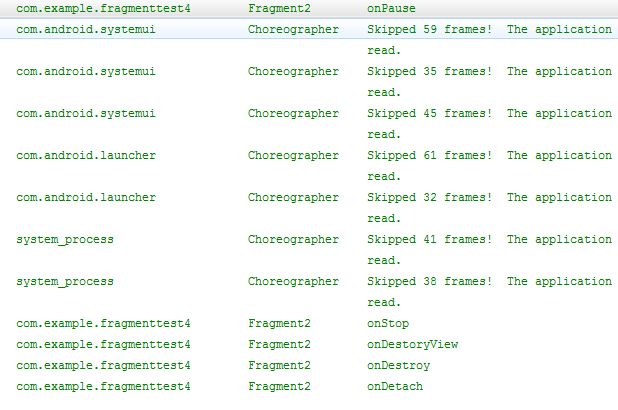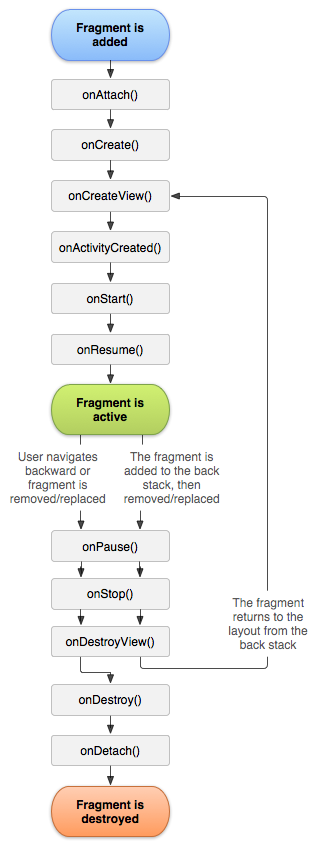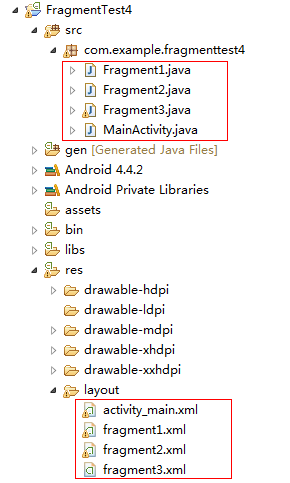Android學習之碎片的生命週期
一、碎片的狀態:
1、執行狀態:當一個碎片是可見的,並且它所關聯的活動正處於執行狀態時,該碎片也處於執行狀態。
2、暫停狀態:當一個活動進入暫停狀態時(由於另一個未佔滿螢幕的活動被新增到了棧頂),與它相關聯的可見碎片就會進入到暫停狀態。
3、停止狀態:當一個活動進入停止狀態時,與它相關聯的碎片就會進入到停止狀態。或者通過呼叫 FragmentTransaction 的 remove()、replace()方法將碎片從活動中移除,但有在事務提交之前呼叫addToBackStack()方法,這時的碎片也會進入到停止狀態。總的來說,進入停止狀態的碎片對使用者來說是完全不可見的,有可能會被系統回收。
4、銷燬狀態:碎片總是依附於活動而存在的,因此當活動被銷燬時,與它相關聯的碎片就會進入到銷燬狀態。或者通過呼叫FragmentTransaction 的 remove()、replace()方法將碎片從活動中移除,但在事務提交之前並沒有呼叫 addToBackStack()方法,這時的碎片也會進入到銷燬狀態。
二、碎片的回撥方法:
Fragment類提供了一系列的回撥方法,以覆蓋碎片的每個環節,主要的回撥方法有:
1、onAttach():當碎片和活動建立關聯的時候呼叫。
2、onCreateView():為碎片建立檢視(載入佈局)時呼叫。
3、onActivityCreated():確保與碎片相關聯的活動一定已經建立完畢的時候呼叫。
4、onDestroyView():當與碎片關聯的檢視被移除的時候呼叫。
5、onDetach():當碎片和活動解除關聯的時候呼叫。
三、碎片完整的生命週期,如下圖所示,圖片來自Android官網:
四、接下來附上一個例子來實踐一下碎片的生命週期:
1、首先新建一個專案,專案名為FragmentTest4,專案結構圖如下:
2、專案效果如下:

點選Hello Lc按鈕後,如下圖所示:
3、首先,新建3個碎片的佈局檔案,分別為fragment1.xml,fragment2.xml,fragment3.xml,其中第三個碎片的佈局中的TextView設定無內容,程式碼分別如下:
fragment1.xml:
<?xml version="1.0" encoding="utf-8"?>
<LinearLayout xmlns:android="http://schemas.android.com/apk/res/android"
android:layout_width="match_parent" fragment2.xml:
<?xml version="1.0" encoding="utf-8"?>
<LinearLayout xmlns:android="http://schemas.android.com/apk/res/android"
android:layout_width="match_parent"
android:layout_height="match_parent"
android:orientation="vertical" >
<TextView
android:id="@+id/textView"
android:layout_width="wrap_content"
android:layout_height="wrap_content"
android:layout_gravity="center"
android:text="Hello xg"
android:textSize="20sp"/>
</LinearLayout>
fragment3.xml:
<?xml version="1.0" encoding="utf-8"?>
<LinearLayout xmlns:android="http://schemas.android.com/apk/res/android"
android:layout_width="match_parent"
android:layout_height="match_parent"
android:orientation="vertical" >
<TextView
android:id="@+id/textView1"
android:layout_width="wrap_content"
android:layout_height="wrap_content"
android:layout_gravity="center"
android:textSize="20sp"/>
</LinearLayout>
4、新建三個類,分別為Fragment1,Fragment2,Fragment3類,繼承於Fragment類,用來載入碎片佈局檔案,程式碼分別如下:
Fragment1.java:
package com.example.fragmenttest4;
import android.app.Fragment;
import android.os.Bundle;
import android.view.LayoutInflater;
import android.view.View;
import android.view.ViewGroup;
public class Fragment1 extends Fragment {
@Override
public View onCreateView(LayoutInflater inflater, ViewGroup container,
Bundle savedInstanceState) {
// TODO Auto-generated method stub
View view=inflater.inflate(R.layout.fragment1, container);
return view;
}
}
Fragment2.java,分別添加了碎片的回撥方法,列印相關的資訊:
package com.example.fragmenttest4;
import android.app.Activity;
import android.app.Fragment;
import android.os.Bundle;
import android.util.Log;
import android.view.LayoutInflater;
import android.view.View;
import android.view.ViewGroup;
import android.widget.TextView;
public class Fragment2 extends Fragment {
public static final String TAG = "Fragment2";//宣告一個字串常量,列印資訊時的TAG
public TextView textView;//宣告一個TextView物件
private Fragment2 fragment2;//宣告Fragment2物件
private String xg;//宣告字串物件
@Override
public void onAttach(Activity activity) {
// TODO Auto-generated method stub
Log.i(TAG, "onAttach");
super.onAttach(activity);
}
@Override
public void onCreate(Bundle savedInstanceState) {
// TODO Auto-generated method stub
Log.i(TAG, "onCreate");
super.onCreate(savedInstanceState);
}
@Override
public View onCreateView(LayoutInflater inflater, ViewGroup container,
Bundle savedInstanceState) {
Log.i(TAG, "onCreateView");
View view = inflater.inflate(R.layout.fragment2, container);//載入fragment2.xml佈局檔案
textView=(TextView)view.findViewById(R.id.textView);//獲得fragment2.xml檔案的TextView控制元件例項
MainActivity activity=(MainActivity) getActivity();//獲得MainActivity例項
fragment2=(Fragment2) activity.getFragmentManager().findFragmentById(R.id.fragment2);//通過活動例項獲得Fragment2物件
xg=fragment2.textView.getText().toString();//獲取文字內容
return view;//返回此檢視
}
@Override
public void onActivityCreated(Bundle savedInstanceState) {
// TODO Auto-generated method stub
Log.i(TAG, "onActivityCreated");
super.onActivityCreated(savedInstanceState);
}
@Override
public void onStart() {
// TODO Auto-generated method stub
Log.i(TAG, "onStart");
super.onStart();
}
@Override
public void onResume() {
// TODO Auto-generated method stub
Log.i(TAG, "onResume");
//假如此碎片恢復的話
if(fragment2.isResumed()){
textView.setText(xg);//設定文字檢視顯示
}
super.onResume();
}
@Override
public void onPause() {
// TODO Auto-generated method stub
Log.i(TAG, "onPause");
super.onPause();
}
@Override
public void onStop() {
// TODO Auto-generated method stub
Log.i(TAG, "onStop");
super.onStop();
}
@Override
public void onDestroyView() {
// TODO Auto-generated method stub
Log.i(TAG, "onDestoryView");
super.onDestroyView();
}
@Override
public void onDestroy() {
// TODO Auto-generated method stub
Log.i(TAG, "onDestroy");
super.onDestroy();
}
@Override
public void onDetach() {
// TODO Auto-generated method stub
Log.i(TAG, "onDetach");
super.onDetach();
}
}
Fragment3.java:
package com.example.fragmenttest4;
import android.app.Fragment;
import android.app.FragmentManager;
import android.app.FragmentTransaction;
import android.os.Bundle;
import android.view.LayoutInflater;
import android.view.View;
import android.view.ViewGroup;
import android.widget.TextView;
public class Fragment3 extends Fragment {
public TextView textView1;
@Override
public View onCreateView(LayoutInflater inflater, ViewGroup container,
Bundle savedInstanceState) {
View view=inflater.inflate(R.layout.fragment3, container,false);//載入fragment3.xml佈局檔案
textView1=(TextView)view.findViewById(R.id.textView1);//獲取fragment3.xml檔案的TextView控制元件例項
MainActivity activity=(MainActivity) getActivity();//獲取MainActivity活動例項
Fragment2 fragment2=(Fragment2) activity.getFragmentManager().findFragmentById(R.id.fragment2);//通過活動例項獲取Fragment2物件
fragment2.textView.setText("");//設定Fragment2碎片的TextView為空
String text=activity.button.getText().toString();//獲取到MainActivity中按鈕的文字內容
textView1.setText(text);//設定Fragment3碎片的TextView的內容
return view;//返回檢視
}
}
我在上面加了一些邏輯,此專案點選Hello Lc按鈕後,右邊碎片改變為此按鈕的文字內容“Hello Lc”,而點選返回鍵要返回上一個碎片,所以必須在Fragment2類中的onResume()方法重新設定該文字內容。
5、接著開啟預設的activity_main.xml佈局檔案,用來新增兩個碎片。其中右邊碎片放在FrameLayout容器中,以便動態呼叫碎片,程式碼如下:
<LinearLayout xmlns:android="http://schemas.android.com/apk/res/android"
xmlns:tools="http://schemas.android.com/tools"
android:layout_width="match_parent"
android:layout_height="match_parent" >
<fragment
android:id="@+id/fragment1"
android:name="com.example.fragmenttest4.Fragment1"
android:layout_width="0dp"
android:layout_height="match_parent"
android:layout_weight="1"/>
<FrameLayout
android:id="@+id/frameLayout"
android:layout_width="0dp"
android:layout_height="match_parent"
android:layout_weight="1" >
<fragment
android:id="@+id/fragment2"
android:name="com.example.fragmenttest4.Fragment2"
android:layout_width="match_parent"
android:layout_height="match_parent"/>
</FrameLayout>
</LinearLayout>6、修改預設類MianActivity,實現了動態呼叫碎片的方法,程式碼如下:
package com.example.fragmenttest4;
import android.app.Activity;
import android.app.FragmentManager;
import android.app.FragmentTransaction;
import android.os.Bundle;
import android.view.View;
import android.view.View.OnClickListener;
import android.widget.Button;
public class MainActivity extends Activity {
public Button button;//宣告Button物件
@Override
protected void onCreate(Bundle savedInstanceState) {
super.onCreate(savedInstanceState);
setContentView(R.layout.activity_main);//載入activity_main.xml檔案
button = (Button) findViewById(R.id.button);//獲取到左邊碎片的按鈕控制元件例項
//新增按鈕點選事件監聽器
button.setOnClickListener(new OnClickListener() {
@Override
public void onClick(View arg0) {
// TODO Auto-generated method stub
Fragment3 fragment3=new Fragment3();//例項化Fragment3物件
FragmentManager fragmentManager=getFragmentManager();//獲取FragmentManager物件
FragmentTransaction fragmentTransaction=fragmentManager.beginTransaction();//開始事務
fragmentTransaction.replace(R.id.frameLayout, fragment3);//動態呼叫碎片,即將原始右邊碎片Fragment2改為Fragment3碎片
fragmentTransaction.addToBackStack(null);//新增到返回棧,即點選返回鍵返回上一個碎片
fragmentTransaction.commit();//提交事務
}
});
}
}
7、執行後效果如上所說一樣,此專案的回撥方法都是放在Fragment2碎片中:
(1)、然後開始執行此應用時,Log列印如下:

當 Fragment2第一次被載入到螢幕上時,會依次執行 onAttach() 、onCreate() 、onCreateView() 、onActivityCreated() 、onStart() 和 onResume() 方法。
(2)、然後點選Fragment1中的按鈕,如下圖所示:

由於Fragment3替換了Fragment2,此時的Fragment2進入了停止狀態,因此 onPause()、onStop()和 onDestroyView()方法會得到執行。當然如果在替換的時候沒有呼叫addToBackStack()方法,此時的 RightFragment 就會進入銷燬狀態,onDestroy()和onDetach()方法就會得到執行。
(3)、接著,按下返回物理鍵,Fragment2會重新回到螢幕,此時列印資訊如下:

由於Fragment2重新回到了執行狀態,因此onActivityCreated()、onStart()和 onResume()方法會得到執行。注意此時 onCreate()和 onCreateView()方法並不會執行,因為我們藉助了addToBackStack()方法使得Fragment2和它的檢視並沒有銷燬。
(4)、再次按返回物理鍵,列印資訊如下:

依次會執行 onPause()、onStop()、onDestroyView()、onDestroy()和 onDetach()方法,最終將活動和碎片一起銷燬。
五、學習了碎片的生命週期,我們可以在碎片的某種特定狀態下進行我們的邏輯操作,比如,我上面舉的例子,就是在Fragment2重新回到執行狀態,即回撥方法onResume()中進行操作,使得重新回到執行狀態的Fragment2碎片的TextView顯示原來的內容。



